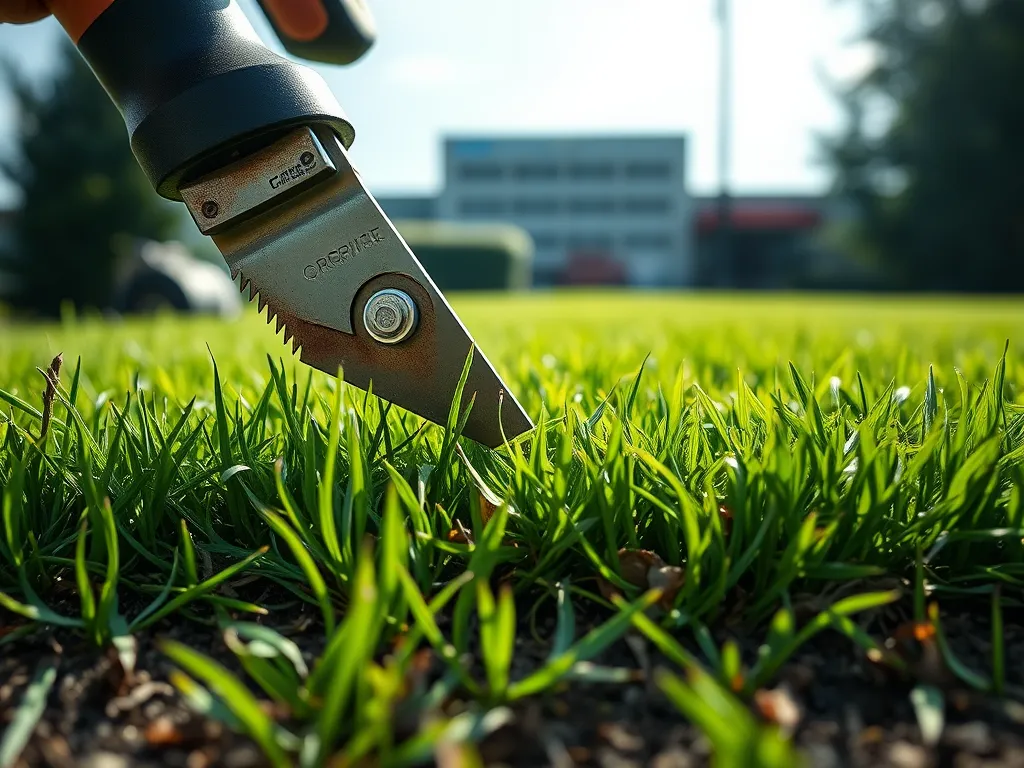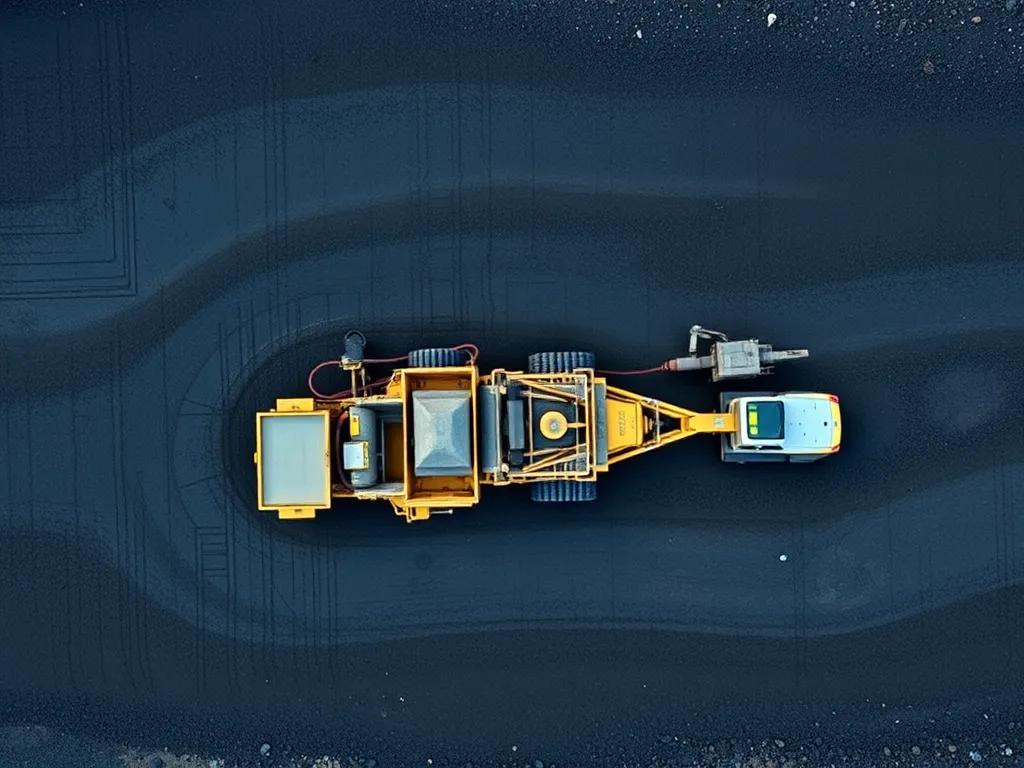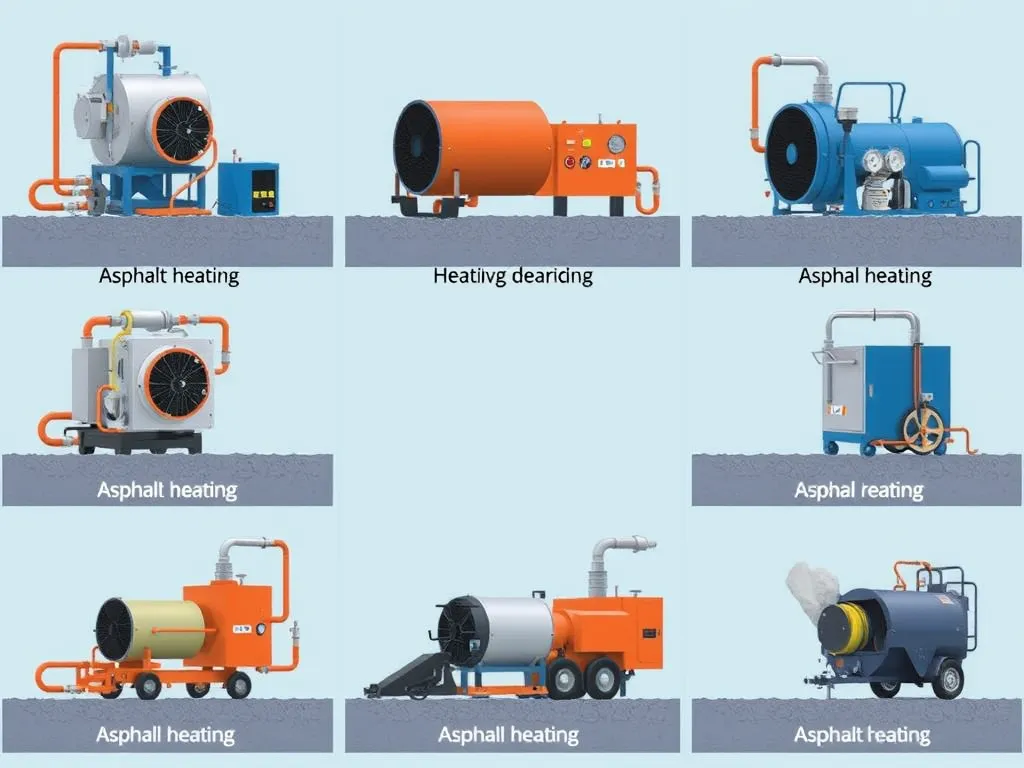Mastering Asphalt Edging: Best Practices for a Flawless Finish
Published on: September 6, 2025 | Last Updated: April 14, 2025
Written By: George Voss
Edgers create sharp borders between asphalt surfaces and adjacent areas like concrete or grass. Proper edging prevents cracks, improves drainage, and boosts curb appeal. For professional results, focus on three elements: surface preparation, tool selection (manual vs. motorized), and consistent technique. Skilled edging extends pavement life by 20-30% by blocking water infiltration and edge raveling.
This guide covers asphalt edging from start to finish. Learn how to prep surfaces by cleaning debris and marking paths. Compare manual edgers (under $150) to gas-powered models (up to $1,200). Master straight-line cuts and curve handling. Find maintenance routines like blade sharpening and storage. Get answers to common cost and timing questions.
Contents
- Understanding the Role Of Edging in Asphalt Surfaces
- Preparing Asphalt Surfaces for Edging
- Selecting the Right Edging Tools for Asphalt
- Asphalt Edging Techniques for Precision
- Maintaining Edgers for Long-term Performance
- Environmental Considerations for Asphalt Edging
- FAQ: Common Asphalt Edging Questions
- Closing Thoughts
- Additional Resources for You:
Understanding the Role Of Edging in Asphalt Surfaces
Edging shapes asphalt surfaces by creating defined borders that lock materials in place. This process prevents premature deterioration while enhancing visual appeal. Let’s break down how precise edging impacts longevity, safety, and curb appeal.
Why Asphalt Edging Matters for Durability
Asphalt edges left untrimmed invite water infiltration, the top cause of base layer erosion. Proper edging seals gaps between asphalt and adjacent surfaces like concrete or soil, blocking moisture from softening the aggregate base. Thermal expansion gaps cut with edgers also reduce stress cracks by 40-60% in freeze-thaw cycles.
| Threat | Edging Solution | Impact |
|---|---|---|
| Water intrusion | 1-2” deep cut | Prevents 80% of edge raveling |
| Rutting | Reinforced borders | Extends pavement life by 3-5 years |
| Weed growth | Clean vertical cuts | Eliminates 90% of vegetation intrusion |
Defining Clean Borders for Safety and Aesthetics
Sharp edges eliminate tripping hazards along walkways and driveways. A 2023 study by the National Asphalt Pavement Association found chamfered edges reduce pedestrian accidents by 22% compared to ragged borders. Visually, crisp lines frame asphalt surfaces, boosting property value by 5-7% in residential settings.
| Feature | Safety Benefit | Aesthetic Impact |
|---|---|---|
| 45° beveled edge | Meets ADA slope standards | Adds modern, polished look |
| Contrast lines | Increases visibility at night | Accentuates landscape design |
For best results, pair edger techniques like straight-line cutting with periodic inspections. Up next: preparing surfaces to maximize edging precision.
Preparing Asphalt Surfaces for Edging
Proper prep work sets the foundation for crisp, long-lasting edges. Skipping this step risks jagged cuts or uneven lines.
Cleaning Debris and Loose Asphalt
Remove rocks, dirt, or broken pavement chunks with stiff-bristle brooms or leaf blowers. For stubborn grime, use power washers set below 3,000 PSI to prevent surface damage. Clearing debris prevents edger blades from catching on loose material, which causes uneven cuts.
Inspecting for Cracks or Uneven Areas
Check the entire work zone for cracks wider than 1/4 inch or dips deeper than 1/2 inch. Fill gaps with cold-patch asphalt compound or polymer-modified crack filler. Grind down raised spots using rotary grinders set to 5-7 mm depth. Level surfaces let edgers glide smoothly without bouncing.
Marking Edging Paths With Chalk or Spray
Outline edges with bright chalk lines or non-toxic marking paint. For curved borders, use flexible garden hoses as guides. Maintain 2-3 inches between the pavement edge and adjacent surfaces like grass or concrete. Clear markings prevent blade drift during edger operation.
With surfaces prepped, the next step is choosing tools built to handle asphalt’s rugged texture. Let’s explore edger types optimized for different project scales.

Selecting the Right Edging Tools for Asphalt
Choosing the correct edging tool directly impacts the quality of your project. Factors like surface type, project scale, blade design, ergonomic grip, and blade material determine which tool delivers clean lines while reducing physical strain.
Types Of Edgers for Asphalt Applications
Edgers fall into two primary groups based on operation style. Each serves distinct purposes depending on surface hardness, project size, and desired edge depth.
Manual Asphalt Edgers
Manual edgers feature steel blades with 6-10 mm thickness, suited for minor repairs or residential driveways. These tools work best on cured surfaces below 120°F. Push-style models cut 1-2 inch deep kerfs, ideal for shaping borders next to grass or concrete. Budget-friendly options range from $50-$150, but require frequent blade sharpening every 8-10 hours of use.
Motorized Edgers for Heavy-Duty Use
Gas or electric motorized edgers tackle commercial parking lots or roads. Their diamond-tipped blades rotate at 2,000-3,500 RPM, slicing through compacted asphalt up to 4 inches thick. Look for models with 14-18 lb weight distribution to minimize vibration during extended operation. Rental costs run $75-$120 per day, while commercial-grade units sell for $300-$800.
Key Features to Prioritize (Blade Strength, Weight, Precision)
| Feature | Specifications | Impact on Performance |
|---|---|---|
| Blade Hardness | 55-62 HRC (Rockwell C scale) | Resists chipping on aggregate-rich mixes |
| Tool Weight | Under 15 lbs for handheld | Reduces fatigue during 6+ hour shifts |
| Cutting Guide | Adjustable 0-45° angles | Enables curved edges without blade binding |
Prioritize blades with carbide tips for cold-mix asphalt. Check handle grips for non-slip rubber coatings—critical when working in humid conditions. Test balance by holding the tool at 30°; it shouldn’t tilt forward or backward.
With the right tool in hand, the next step involves refining edger techniques for crisp, lasting borders.
Also See: Asphalt Installation Costs: A Detailed Breakdown
Asphalt Edging Techniques for Precision
Mastering edger techniques ensures crisp transitions between asphalt and surrounding surfaces. Proper execution prevents crumbling edges, water infiltration, and uneven wear over time.
Step-by-step Guide to Edging Straight Lines
Straight lines demand methodical planning. Start with pre-marked paths using chalk or spray paint for visible guidance.
Aligning the Edger with Marked Paths
Position the edger blade 1-2 inches inside your marked line to account for blade width. For gas-powered models, engage the blade guard to avoid surface scratches. Keep wheels parallel to the guide for steady tracking. Adjust handle height to maintain a 10-15° blade angle—this balances cutting depth and control.
Maintaining Consistent Pressure
Apply 15-20 pounds of downward force on manual edgers. Too little pressure skips cuts; too much strains the blade. For motorized units, let the machine’s weight do the work—avoid leaning. Move forward at 1-2 feet per second, overlapping each pass by 3 inches to eliminate gaps.
Edging Curves and Corners in Asphalt
For curves, pivot the edger handle—not the blade—to follow tight radii. Reduce speed to 6-8 inches per second on arcs under 3 feet. Switch to a half-moon edger for corners under 90°. Score the asphalt lightly first, then deepen cuts in 1/4-inch increments to prevent jagged edges.
Managing Joints Between Asphalt and Adjacent Surfaces
Create a 1/8-inch gap between asphalt and concrete/grass to allow for expansion. Backfill joints with polymeric sand or cold-applied sealant. For grass borders, angle the edger blade 30° outward to form a V-shaped trough that blocks root intrusion. Check joints with a 4-foot level—slope should drop 1/4 inch per foot away from asphalt.
Precision edging sets the stage for long-lasting results. But even the sharpest techniques won’t matter if your tools aren’t maintained. Next, we’ll break down how to keep edgers performing like new.

Maintaining Edgers for Long-term Performance
Regular upkeep ensures edgers deliver crisp lines project after project. Neglected tools degrade faster, increasing repair costs by 30-50% annually. Follow these core strategies to preserve blade sharpness and mechanical reliability.
Cleaning Asphalt Residue After Use
Remove sticky bitumen chunks immediately post-use. Letting asphalt harden on blades or wheels strains motors and causes uneven cuts. Scrape thick buildup with a putty knife, then scrub with mineral spirits. For electric edgers, avoid spraying liquids near wiring – use dry brushes for gear housings.
Sharpening Blades for Clean Cuts
Dull blades tear asphalt edges, creating ragged lines that collect water. Sharpen carbide-tipped blades every 10-15 operating hours using a 120-grit diamond file. Check angle consistency with a protractor – most asphalt edgers require a 25° bevel. Test sharpness by slicing paper; clean cuts mean ready-to-work edges.
Lubricating Moving Parts
Friction from asphalt dust accelerates wear on pivot points and bearings. Apply lithium-based grease to axle joints weekly during heavy use. For gas-powered models, lubricate throttle linkages with silicone spray monthly. Avoid WD-40 on load-bearing parts – it attracts grit that grinds down metal surfaces.
Proper Storage to Prevent Rust or Damage
Store edgers vertically on wall hooks or horizontally on elevated racks. Apply a light oil coating to blades before stowing. In humid climates, use silica gel packs in storage cases to control moisture. Never leave tools in direct sunlight – UV rays degrade rubber handles and plastic components.
With blades prepped and parts protected, you’re set to tackle advanced edging strategies. Next, we’ll explore eco-friendly methods to handle asphalt waste while keeping sites compliant.
Environmental Considerations for Asphalt Edging
Professional asphalt edging requires balancing precision with environmental stewardship. Tackling debris management and air quality protects ecosystems while meeting project specs.
Disposing Of Asphalt Debris Responsibly
Recycle millings and cut-offs through local asphalt recycling programs – 95% of removed material gets reused in new pavement mixes. Store debris in sealed containers until transport to prevent leaching. Check state regulations: California requires permits for hauling over 50 lbs of asphalt waste. Recycling cuts disposal costs by $12-$18 per ton compared to landfill fees.
Minimizing Dust and Particulate Spread
Use wet edging techniques with misting systems to suppress airborne particles. Gas-powered edgers generate PM2.5 levels up to 8x higher than electric models – switch when working near sensitive areas. Contain workspaces with silt fences and deploy vacuums with HEPA filters catching 99.97% of particulates. Workers should wear NIOSH-approved N95 respirators during dry cuts.
These measures align with EPA stormwater regulations while sharpening your edging techniques. Up next: Answers to frequent queries about how to use edgers in tricky scenarios.

FAQ: Common Asphalt Edging Questions
What Do Professionals Use for Asphalt Edging?
Professionals often use a combination of manual and motorized edgers tailored to the size and type of project. Manual edgers are typically used for residential tasks, while motorized edgers are preferred for larger, commercial jobs. The choice depends on efficiency, precision, and the required depth of the edge.
How Much Will 100 Feet Of Asphalt Edging Cost?
The cost of asphalt edging can vary widely, depending on the type of materials used and the complexity of the job. On average, homeowners can expect to pay between $10 to $20 per linear foot, so for 100 feet, the total would range from $1,000 to $2,000. This includes labor and materials, but exact pricing should be determined through a detailed cost estimate from a contractor.
Is It Better to Edge Asphalt When Wet or Dry?
It’s generally advisable to edge asphalt when it is dry. Wet surfaces can make it difficult for edgers to create clean cuts, leading to jagged edges and less precision. Moreover, wet conditions may cause slipping or increase the risk of damage to the edger’s blades.
How to Edge Asphalt Borders by Hand?
To edge asphalt borders by hand, start with a manual edger. Mark your desired border lines clearly with chalk. Position the edger along the marked line and apply consistent pressure as you push it forward, ensuring to maintain a straight path. For curves, gently pivot the edger to follow the desired shape. Regularly check the depth of your cuts to maintain uniformity.
Closing Thoughts
Mastering the use of edgers can significantly enhance the appearance and durability of asphalt surfaces. By following best practices such as selecting the right tools, employing precise techniques, and maintaining your equipment, you can achieve a professional finish.
Remember to keep your workspace clean and environmentally responsible, ensuring that asphalt debris is disposed of properly and minimizing dust. Regular upkeep of your edgers will sustain their performance and extend their lifespan.
For further details and expert advice on asphalt work, visit Asphalt Calculator USA. Elevate your asphalt projects with the right insights and resources!
Additional Resources for You:
- Huang, Y. H. (2004). Pavement Analysis and Design (2nd ed.). Upper Saddle River, NJ: Pearson/Prentice Hall.
- Lawn Edging: A Comprehensive Guide for a Perfect Finish – GreenThumb
- The Importance Of Edging And Jointing in Concrete Finishing – Tomahawk Power
- 5 Best Edgers For Barbers. Using the best edger for barbers can… | by Sneha Goud | Medium
- How to Use a Paint Edger


